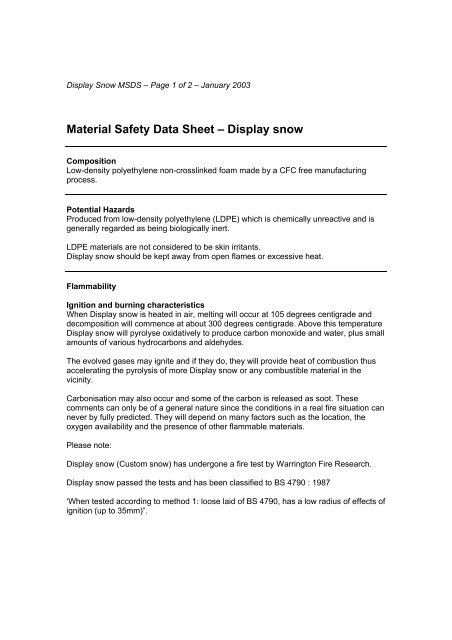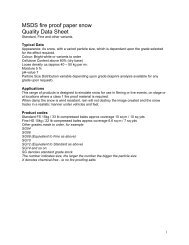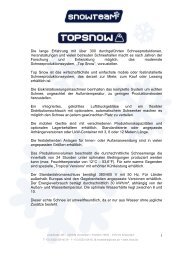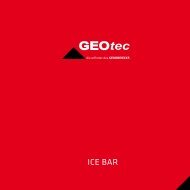Material Safety Data Sheet â Display snow
Material Safety Data Sheet â Display snow
Material Safety Data Sheet â Display snow
Create successful ePaper yourself
Turn your PDF publications into a flip-book with our unique Google optimized e-Paper software.
<strong>Display</strong> Snow MSDS – Page 1 of 2 – January 2003<br />
<strong>Material</strong> <strong>Safety</strong> <strong>Data</strong> <strong>Sheet</strong> – <strong>Display</strong> <strong>snow</strong><br />
Composition<br />
Low-density polyethylene non-crosslinked foam made by a CFC free manufacturing<br />
process.<br />
Potential Hazards<br />
Produced from low-density polyethylene (LDPE) which is chemically unreactive and is<br />
generally regarded as being biologically inert.<br />
LDPE materials are not considered to be skin irritants.<br />
<strong>Display</strong> <strong>snow</strong> should be kept away from open flames or excessive heat.<br />
Flammability<br />
Ignition and burning characteristics<br />
When <strong>Display</strong> <strong>snow</strong> is heated in air, melting will occur at 105 degrees centigrade and<br />
decomposition will commence at about 300 degrees centigrade. Above this temperature<br />
<strong>Display</strong> <strong>snow</strong> will pyrolyse oxidatively to produce carbon monoxide and water, plus small<br />
amounts of various hydrocarbons and aldehydes.<br />
The evolved gases may ignite and if they do, they will provide heat of combustion thus<br />
accelerating the pyrolysis of more <strong>Display</strong> <strong>snow</strong> or any combustible material in the<br />
vicinity.<br />
Carbonisation may also occur and some of the carbon is released as soot. These<br />
comments can only be of a general nature since the conditions in a real fire situation can<br />
never by fully predicted. They will depend on many factors such as the location, the<br />
oxygen availability and the presence of other flammable materials.<br />
Please note:<br />
<strong>Display</strong> <strong>snow</strong> (Custom <strong>snow</strong>) has undergone a fire test by Warrington Fire Research.<br />
<strong>Display</strong> <strong>snow</strong> passed the tests and has been classified to BS 4790 : 1987<br />
‘When tested according to method 1: loose laid of BS 4790, has a low radius of effects of<br />
ignition (up to 35mm)”.
<strong>Display</strong> Snow MSDS – Page 2 of 2 – January 2003<br />
Products of combustion<br />
The main combustion product in flaming conditions is generally carbon dioxide, though<br />
lack of oxygen or rapid extinguishing of the fire often leads to the smoke still containing<br />
appreciable quantities of carbon monoxide, acrolein and aldehydes. The<br />
pyrolysis/combustion behaviour is very similar to that of wood and other cellulosic<br />
materials though there are differences in detail.<br />
Density (as a solid)<br />
30Kg/m 3 nominal density<br />
Test method: DIN 53420<br />
Colour:<br />
Environmental Advantages:<br />
Semi Opaque / White / Anti-Static<br />
Due to high performance of <strong>Display</strong> <strong>snow</strong> foam it<br />
can be reused. As with most polyethylene<br />
products the foam can easily be recycled.<br />
<strong>Display</strong> <strong>snow</strong> polyethylene flake is manufactured<br />
by a CFC and HCFC free process.<br />
5. Physical properties<br />
Anti-static <strong>Display</strong> <strong>snow</strong> is formulated to prevent the generation of static electricity during<br />
handling and distribution.<br />
The <strong>Display</strong> <strong>snow</strong> meets the following specifications:<br />
1. Static decay – less than 2 seconds from 5,000 volts to 37 volts. Tested to US<br />
Federal test method standard 101C, method 4046, in MIL-B-81705B.<br />
2. Surface resistivity – less than 10 to the power of 13 ohms/square. Tested to<br />
ASTM standard D-257.<br />
6. Other Information<br />
The statements in this document were made to the best of our knowledge and are as<br />
accurate as possible. They are given for information only. They do not constitute a<br />
contractual guarantee of a product’s properties. They must neither be altered nor<br />
transferred to other products.





